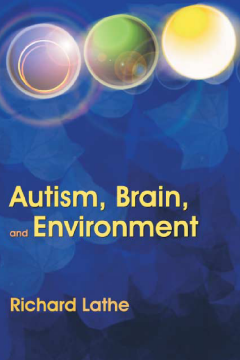
Additional Information
Book Details
Abstract
The increasing number of people being diagnosed with autism spectrum disorders (ASDs) cannot simply be explained by changes in diagnostic criteria or greater awareness of the condition. In this controversial new book, Richard Lathe contends that the recent rise in cases of ASDs is a result of increased exposure to environmental toxicity combined with genetic predisposition.
Autism, Brain, and Environment proposes that autism is a disorder of the limbic brain, which is damaged by toxic heavy metals present in the environment. Lathe argues that most ASD children have additional physiological problems and that these, far from being separate from the psychiatric aspects of ASD, can produce and exacerbate the condition.
This important and groundbreaking text provides a closely-argued scientific case for the involvement of both environmental and physiological factors in autism. Lathe's argument will also have a direct impact on treatment strategies and options. It will be of great interest to the scientific community, professionals, researchers, political and environmental lobbyists, teachers, psychologists, and parents and people with ASDs.
I would recommend this book to psychologists working in the field of ASD who want a clear and well argued introduction to a subject which although undoubtedly controversial deserves serious attention.
Dr. Bob Walley, Consultant Clinical Psychologist
Autism, Brain and Environment engages with wider scientific debate and is comprehensively researched.
Journal of Biosocial Science
This densely informative book is a comfort to read. One can browse or follow through. The index is enormous and useful. Definitions are strengthened. Gene and brain variations are covered and the nature/nurture interaction exposed.
The Galton Institute Newsletter
Richard Lathe is director of Pieta Research, a biotechnology consultancy based in Edinburgh. He has extensive experience of academic and industrial research, his most recent area of interest has been in brain research and neuroscience, particularly focusing on the limbic system, autism and Alzheimer's. He has previously held professorship at the Universities of Edinburgh and Strasbourg. He is the author of over one hundred peer-reviewed journal articles.
The author covers the problems of recognition and diagnosis, genetic contributions, brain abnormalities, limbic dysfunction, physiological dysregulation, body and mind, biomedical therapy, and links with other disorders, as part of a detailed positioning of this arguments... The argument is concisely presented, extensively referenced and made easy to follow to its conclusion... Overall this is an important book, well argued and referenced. It should be read by all concerned with ASD.
The Journal of The Royal Society for the Promotion of Health, JRSH
Autism. Brain and Environment provides a new account of the biological basis for autism, with consequences for a wide range of professionals as well as for families.
Psychology Teaching Review
I would recommend this book to psychologists working in the field of ASD who want a clear and well argued introduction to a subject which, although undoubtedly controversial, deserves serious attention.
Clinical Psychology Forum
This is a well- written user- friendly book. The key points at the end of the chapters give a helpful summary. The book presents a comprehensive overview of the aetiological factors in autistic disorders with extensive bibliography... Richard Lathe makes an excellent case for the interplay of factors and gives an unbiased presentation of the available evidence for all the possible hypotheses in the causation of autistic syndromes. The section on the impact of heavy metal toxicity is particularly interesting... This is an important book that brings together all the current issues in the aetiology of autistic disorders. The chapter on biomedical therapy, subtyping and interventions gives possible ways forward in management which may seem well worth adapting in clinical practise. This is a must- read book for trainees in psychiatry and paediatrics and for practitioners in the field.
Journal of Intellectual Disability Research
Table of Contents
| Section Title | Page | Action | Price |
|---|---|---|---|
| Introduction Rural Industrialisation | |||
| R. van Zwanenberg 5 | |||
| Chapter 1 Community Development | |||
| and Small Industry | |||
| K. Nimpuno 7 | |||
| Chapter 2 Pre-capitalist Industry in | |||
| Eastern Africa | |||
| R. van Zwanenberg 13 | |||
| Chapter 3 Recycling Industry | |||
| L. Berg 19 | |||
| Chapter 4 Workshops Today | |||
| K. Nimpuno 27 | |||
| Chapter 5 Small Scale Production — | |||
| The Contemporary | |||
| Situation | |||
| L. Berg 37 | |||
| Chapter 6 Training for Production | |||
| K. Nimpuno 51 | |||
| Chapter 7 Village Workshop Equipment | |||
| H. Tollin & B. Oscarsson 55 | |||
| Chapter 8 Village Workshop Design | |||
| K. Nimpuno 69 | |||
| Chapter 9 Village Workshop | |||
| Construction | |||
| K. Nimpuno 73 | |||
| Chapter 10 Official View on | |||
| Rural Industry | |||
| K. Nimpuno 79 | |||
| Chapter 11 Towards Village Industry | |||
| K. Nimpuno 85 |
